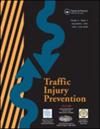提高摩托车安全性:量化自动紧急制动和自适应巡航控制在减少碰撞中的作用。
IF 1.9
3区 工程技术
Q3 PUBLIC, ENVIRONMENTAL & OCCUPATIONAL HEALTH
引用次数: 0
摘要
目的:电动两轮车(PTW)的安全问题一直是人们关注的焦点,这促使人们对高级驾驶辅助系统(ARAS)在降低碰撞率方面的功效进行调查。本研究旨在全面量化自适应巡航控制系统(ACC)和自主紧急制动系统(AEB)这两个系统对避免或减轻摩托车碰撞事故的影响:本研究利用真实世界的摩托车碰撞数据,采用运动学重建技术和数值模拟来评估自适应巡航控制系统(ACC)和自动紧急制动系统(AEB)对减少碰撞的影响。进行了一项参数研究,探讨了包括触发距离、减速率和视野在内的各种参数,以评估它们对该系统在涉及公共交通车辆的碰撞事故中的有效性的影响:分析结果表明,在降低涉及摩托车的碰撞率方面,自动碰撞控制和自动紧急制动系统的效果显著。值得注意的是,ACC,尤其是在触发距离为 40 米的动态模式下,能够防止 53% 的碰撞事故,使碰撞速度降低 4 至 25 公里/小时不等。同样,自动紧急制动系统(AEB)也表现出显著效果,将撞击速度降低了 2.5 至 38.9 公里/小时,避免率从 7% 到 63% 不等:结论:优化关键参数(如触发策略、减速、传感器范围和视野)对于最大限度地提高 ARAS 在摩托车安全应用中的有效性至关重要。这些研究结果为制造商和政策制定者提供了宝贵的见解,强调了在系统设计和实施中采用量身定制方法的必要性。通过在经验数据和分析的基础上改进这些系统,可以显著提高摩托车的安全性,最终挽救生命并降低道路上撞车事故的严重程度。本文章由计算机程序翻译,如有差异,请以英文原文为准。
Enhancing motorcycle safety: Quantifying the effects of Autonomous Emergency Braking and Adaptive Cruise Control in crashes reduction
Objective
Powered 2-wheeler (PTW) safety remains a critical concern, prompting the investigation into the efficacy of advanced rider assistance systems (ARAS) in reducing crash rates. The objective of this study is to provide a comprehensive quantification of the effects of 2 such systems, Adaptive Cruise Control (ACC) and Autonomous Emergency Braking (AEB), on the avoidance or mitigation of motorcycle crashes.
Methods
Using real-world motorcycle crash data, this research employed kinematic reconstruction techniques and numerical simulations to evaluate the impact of ACC and AEB on crash reduction. A parametric study was conducted, exploring various parameters including trigger distances, deceleration rates, and field of view, to assess their influence on the effectiveness of this systems in crashes involving PTWs.
Results
The analysis revealed significant findings regarding the effectiveness of ACC and AEB in reducing crash rates involving motorcycles. Notably, ACC, especially in dynamic mode with a trigger distance of 40 m, demonstrated the ability to prevent 53% of crashes, resulting in impact speed reductions ranging from 4 to 25 km/h. Similarly, AEB exhibited remarkable effectiveness, reducing impact speeds by 2.5 to 38.9 km/h, with avoidance rates ranging from 7% to 63%.
Conclusions
Optimization of key parameters such as triggering strategy, deceleration, sensor range, and field of view is crucial for maximizing the effectiveness of ARAS in motorcycle safety applications. These findings provide valuable insights for manufacturers and policymakers, highlighting the need for tailored approaches to system design and implementation. By refining these systems based on empirical data and analysis, significant improvements can be made in motorcycle safety, ultimately saving lives and reducing the severity of crashes on roadways.
求助全文
通过发布文献求助,成功后即可免费获取论文全文。
去求助
来源期刊

Traffic Injury Prevention
PUBLIC, ENVIRONMENTAL & OCCUPATIONAL HEALTH-
CiteScore
3.60
自引率
10.00%
发文量
137
审稿时长
3 months
期刊介绍:
The purpose of Traffic Injury Prevention is to bridge the disciplines of medicine, engineering, public health and traffic safety in order to foster the science of traffic injury prevention. The archival journal focuses on research, interventions and evaluations within the areas of traffic safety, crash causation, injury prevention and treatment.
General topics within the journal''s scope are driver behavior, road infrastructure, emerging crash avoidance technologies, crash and injury epidemiology, alcohol and drugs, impact injury biomechanics, vehicle crashworthiness, occupant restraints, pedestrian safety, evaluation of interventions, economic consequences and emergency and clinical care with specific application to traffic injury prevention. The journal includes full length papers, review articles, case studies, brief technical notes and commentaries.
 求助内容:
求助内容: 应助结果提醒方式:
应助结果提醒方式:


